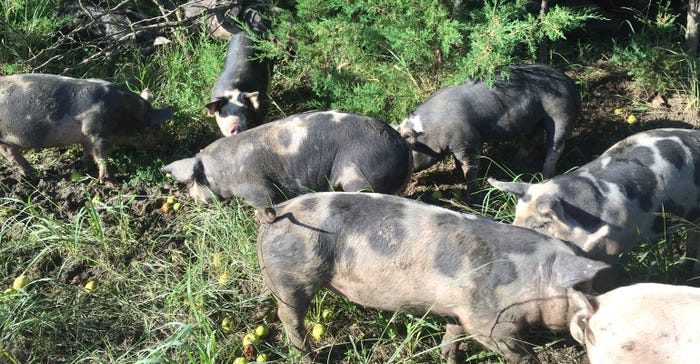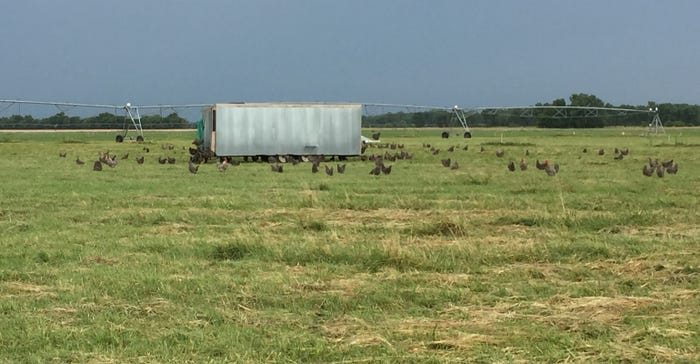
When it comes to figuring out what holistic farm practices will work best for your farm, experimenting might be the best way to go.
For Daniel King, third-generation owner/manager of Jako Farm near Hutchinson, Kan., experimenting has been a lifelong process as he has developed the grass-based, multi-species, seasonal farm. Jako Farms currently direct markets more than 100 products to 2,000 local customers looking for non-GMO, chemical-free food that surpasses organic standards.
King operates the farm with his wife, Robyn, and son, Luke.
 WATER ACCESS: Water tanks on the Jako Farm are accessible in all of the paddocks, which range in size from 3 acres to 30 acres.
WATER ACCESS: Water tanks on the Jako Farm are accessible in all of the paddocks, which range in size from 3 acres to 30 acres.

“We have 125 acres of irrigated perennial forages, 175 acres of dryland perennials mixed with annual forages, and 50 aces of woodlands and pasture,” he told attendees at the annual Agriculture’s Innovative Minds Symposium, held in Wichita, Kan., on Feb. 1.
King said he has the pastures divided in 3 to 30-acre permanent paddocks, which are fenced with two-strand, high-tensile wire. Livestock includes 40 head of milk cows, 100 ewes and lambs, chickens (both broilers and layers), calves, pigs, and a guard llama.
He said the livestock is rotated from paddock to paddock, with each paddock having water access. The sheep and cattle are not fed grain, and no commercial herbicides, pesticides or fertilizers are used. The pigs live in the brushy undergrowth by the river and enjoy a rich diet of roots, skim milk and organic grains.
“We have the cows calving and the ewes lambing at the same time,” he said. “The cows will help protect the lambs from coyotes. And the sheep will bed down in the middle of the cow herd. We’ve learned that, with a little training, we can use the same fencing for multiple species.”
 PIG SPACE: The pigs on the Jako Farm are pastured in the underbrush along the Arkansas River. They forage for roots and are fed a supplemental diet of skim milk and organic grains.
PIG SPACE: The pigs on the Jako Farm are pastured in the underbrush along the Arkansas River. They forage for roots and are fed a supplemental diet of skim milk and organic grains.

The pastured poultry spends the first few weeks of life in a brooder house and are moved out to pasture when they are old enough to tolerate an outdoor climate. They forage on grasses, bugs and insects that they find in the pastures, and are fed a customized, probiotic-enhanced hormone and antibiotic-free supplemental ration.
The grass-fed cattle and lambs are raised from birth on pasture with a blend of grasses, forbs and legumes.
King said that not all the experiments on the farm have been successful. In fact, he said, turkeys were a pretty spectacular fail, and goats didn’t go so well either.
“Actually, we may be looking at trying milking goats again,” he said. “We need to control some woody invasive species, and thistles and goats should be good for that.”
 CHICKENS ROAM: Chickens, both for meat and for eggs, are raised on Jako Farm. Baby chicks are housed in a brooder house until they are old enough to handle outdoor conditions.
CHICKENS ROAM: Chickens, both for meat and for eggs, are raised on Jako Farm. Baby chicks are housed in a brooder house until they are old enough to handle outdoor conditions.

Among the lessons he says he learned the hard way are:
In all, King suggests that you: Match your species to your goals and resources; fence for your smallest species; match the same classes at lambing or calving time; know which animals need their own space; keep infrastructure low and portable; move the animals to a new paddock before they are hungry; train your animals to move from paddock to paddock, and finally cull the animals (such as King’s turkeys) that just aren’t a fit for the operation.
About the Author(s)
You May Also Like




